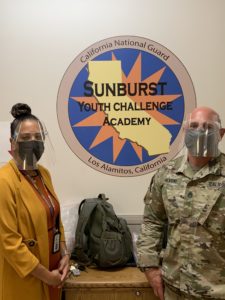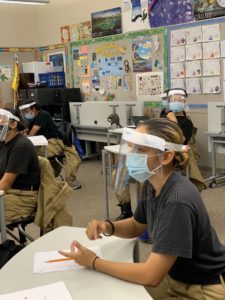A non-traditional high school in Orange County is giving students who’ve faced significant obstacles a second chance at life.
Operated by the California National Guard in partnership with OCDE, Sunburst Youth Academy is a community high school for at-risk youth. Students who attend the program are immersed for five and a half months in a military-style environment where they can earn high school credits while developing leadership, pride, confidence and academic skills.
During their time at Sunburst, cadets live on base, attend high school during the day and work on physical fitness, life skills, team building and goal setting activities before and after school.

The academy focuses on the following eight core components of instruction: Academic Excellence, Job Skills, Physical Fitness, Life Coping Skills, Leadership/Followership, Health and Hygiene, Service to the Community and Responsible Citizenship.
But, like every other aspect of our society, the pandemic has changed the way the recruitment process works for Sunburst. Due to school closures, scheduled visits to local campuses were not able to happen this year. But that hasn’t stopped the team from trying new ways to spread the word about the life-changing transformations that happen at Sunburst.
We recently talked with Sunburst Principal Dinah Ismail and Admissions Coordinator Sergeant Ryan Salvoni about the academy, the application process and what families and prospective cadets can expect from the program.
Here are five things to know about Sunburst Youth Academy.
Sunburst is a credit recovery program.
Cadets attending Sunburst are expected to earn 65 credits, comparable to a year’s worth of high school credits, in five and a half months. Credits earned at Sunburst can be taken back to a student’s home school and applied toward graduation, or a cadet can earn a high school diploma — not just a High School Equivalency Test (HiSET) credential — from Sunburst.
According to Sgt. Salvoni, the average incoming cadet has a grade point average around 1.3 to 2.0 – on a four-point scale – and virtually every student graduates with a 3.7 to a 4.0.
The program is voluntary and free for students to attend.
Sunburst is a voluntary program for students 16 to 18 years of age. Youth attending the program aren’t sentenced to be there by a judge. Through a special scholarship funded by the federal government and the State of California, tuition, room and board, and books are provided to cadets at no cost.
“Sunburst is not a placement facility, it’s not a boot camp for bad kids, parents can’t force their students to attend,” Sgt. Salvoni said. “It’s a scholarship that students and families have to apply for and earn. Students have to have an actual desire for change and make a commitment to the process in order for our program to have significant change in their life.”
To be eligible for the program, applicants must be:
- between the ages of 16-18 on the program start date
- legal residents of Southern California
- free from any serious legal involvement and have no felonies
- willing to be drug-free
- physically and emotionally able to participate
- credit deficient (not on track to graduate on time)
- eager to apply for the academy and have a desire to make positive change
Students are immersed in a holistic approach to learning.
Sunburst focuses on a holistic approach to addressing all the issues teens are facing in today’s world. The academy employs a full-time counseling staff, medical team, case managers, instructors, teachers and more. Cadets perform community service, receive hands-on vocational training and gain resume-building, interviewing and financial skills.
Principal Ismail says that, most importantly, Sunburst builds character.
“Cadets are expected to maintain high moral and ethical standards and each cadet learns the qualities of a good leader, follower and team member, then has a chance to lead their fellow cadets,” Ismail said.
The program focuses on ‘quasi-military’ leadership training.
Located on the Joint Forces Training Base in Los Alamitos, California, Sunburst is staffed and administered by the National Guard. A typical day begins at 5:15 a.m. and is fully scheduled with daily exercise, study and activities until lights-out at 8 p.m.
Cadets are split into platoons – male and female – and have no access to social media, television or contact with the outside world. During the first two weeks of the program, all cadets are provided with gray outfits, and after working hard both academically and mentally, they move up the ranks to earn different military-style uniforms.
California National Guard cadre supervise the cadets, train them on marching and military drills, instill military discipline, lead them in physical fitness, mentor them, and make sure they are where they need to be.
Through a combination of classroom activities, group discussions and Sunburst’s structured living environment, students gain self-esteem and learn to regulate their emotions and employ conflict resolution strategies.
Sunburst does not recruit for the military and is not a military feeder program.
Students graduate with a plan for the future.
The Sunburst program consists of two phases. The first is a structured residential timeline focused on meeting high school requirements and life skills. After the five and a half months are complete, cadets enter a 12-month post-residential stage involving trained mentors who provide guidance and support.
Sunburst gauges its success based on a student’s placement at the conclusion of the 17 and a half months.
“A student must be working, going to school, volunteering, in the military, or a combination of any of these activities for 30 hours a week to be considered ‘positively placed,’” says Ismail. “We are proud to say that we have a success rate of nearly 90 percent of cadets positively placed after completing the program.”
To learn more about the process for referring a student from your district, or for additional information, please visit the Sunburst Youth Academy website.
